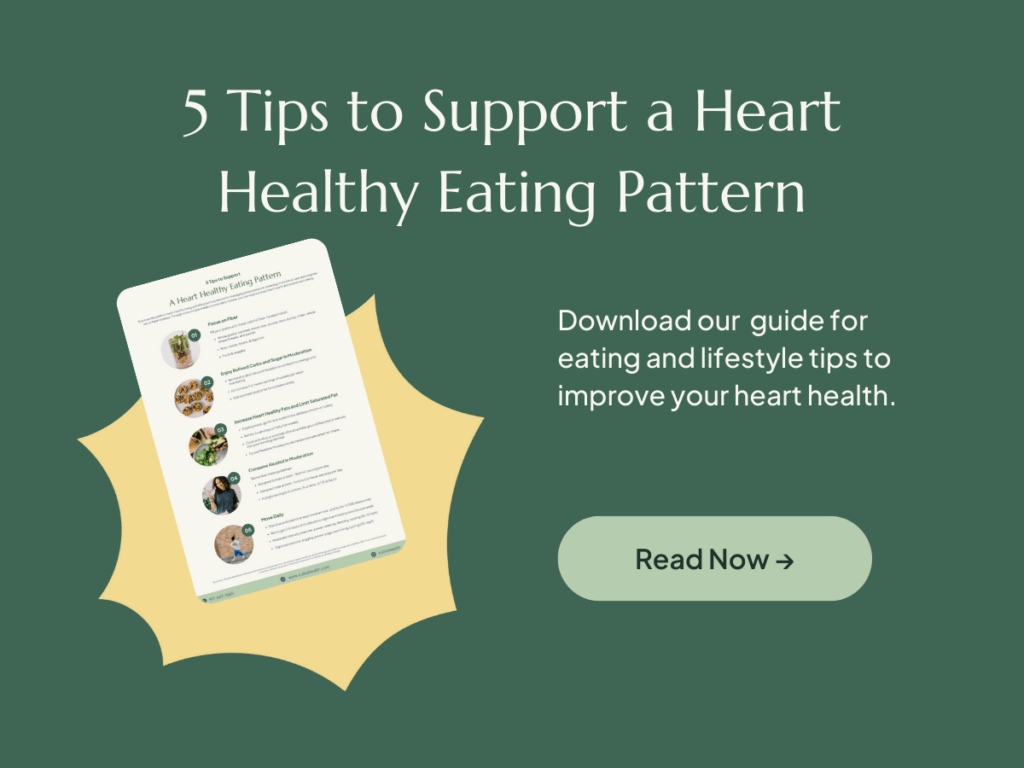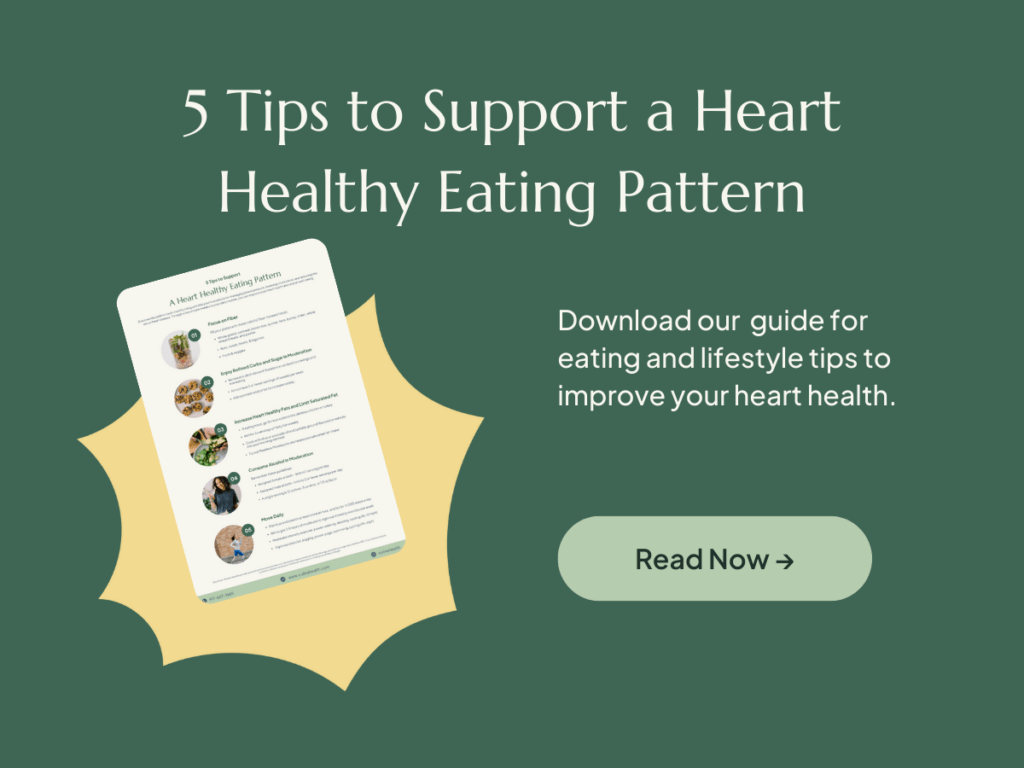How to Improve Heart Health With Nahyeli Perpiñá, MS, RDN, CNSC


According to the Centers for Disease Control, heart disease is the leading cause of death for males and females of most racial and ethnic groups in the United States. If you’re one of the millions of adults living with high blood pressure and/or high cholesterol, taking proactive steps to maintain a healthy heart can reduce your heart disease risk.
In conjunction with American Heart Month, we chatted with one of our registered dietitians, Nahyeli Perpiñá, MS, RDN, CNSC, who shared how she supports patients in improving their cardiovascular health. In this interview, Nahyeli discusses the best foods for heart health, heart healthy lifestyle modifications, and common misconceptions about heart healthy eating.
About Nahyeli Perpiñá, MS, RDN, CNSC
Why did you decide to become a registered dietitian?
I am actually a physician in my home country, the Dominican Republic. But while I was studying medicine, I discovered a passion for nutrition. Physicians are known for not getting enough nutrition education during their coursework, which is true, but I took an elective on nutrition and realized there was much more to do besides just treating disease.
I figured that with nutrition I could help people prevent disease and improve their quality of life. From a nutrition perspective, we tend to see people more as a whole and take into consideration other aspects of their life besides their health conditions. So I feel more useful to my patients that way.
What’s your favorite part of your work as a dietitian?
My favorite part is building rapport with my clients, getting to know them, and being able to have a bird’s eye view on things that maybe they cannot see or don’t realize. I love seeing my patients have these “aha” moments about nutrition and lifestyle changes. And I love seeing how much those changes can impact not only their health, but their whole quality of life.
Working With a Registered Dietitian on Heart Health
When should someone consider seeing a dietitian for their heart health?
As soon as you get a diagnosis that has to do with heart health or vascular health. But even before then, if you have a risk factor — like excess weight, hypertension, diabetes, high cholesterol — or if anyone in your family suffers from a heart or vascular condition, you should see a dietitian to help prevent or manage it.
Can you share a time when you successfully helped a patient improve their heart health? What did you recommend and what results did you see?
I had a patient who just had a stroke at the end of last year. He learned that he had pretty high cholesterol and triglycerides. So we were working together for a few months on increasing his fiber intake, widening the variety of vegetables and fruits that he was eating, and decreasing saturated fat.
We also worked on some stress management techniques and light physical activity that he could incorporate into his day. After he had been very diligently working on those goals, his LDL cholesterol and triglycerides dropped significantly. It is always very rewarding to see patients get the results they worked so hard for.
“I love seeing my patients have these “aha” moments about nutrition and lifestyle changes, and how much those changes can impact not only their health, but their whole quality of life.”
What are some recommendations you typically give to people with cardiovascular disease to help them manage their condition?
The advice I give to people trying to manage disease versus preventing it is pretty similar. But if you already have heart disease, you may want to be even more physically active or increase your fiber within a shorter timeframe. More frequent monitoring of lab work may also be required in conjunction with your physician. This is to check if the interventions are having the desired effect or if medication may be required.
Heart Healthy Eating Patterns and Lifestyle Changes
What’s one thing someone can do today to support their heart health and reduce their heart disease risk?
Increase your vegetable and fruit intake. It doesn’t matter how much vegetables and fiber people think they eat. Most likely, it’s not enough. Increasing vegetables and fruits is the best and maybe the easiest way to improve your heart health.
How does increasing fiber, fruit, and vegetable intake support heart health?
Fiber helps with lower LDL cholesterol, which is also known as the “bad” cholesterol. So that’s one of the main reasons why you want to increase fiber in your diet. But vegetables and fruits also have antioxidants that help maintain the health of your heart and blood vessels.
What are some practical tips you give patients looking to adopt a heart healthy eating pattern while still enjoying their favorite foods?
You can make healthy swaps without actually changing the food you’re eating. For example, instead of whole milk, try 2% milk or skim milk. Or experiment with different cooking methods. Instead of frying, try baking. That’s the advice I give most often so people can still enjoy the same food, but with a healthier twist for their heart health.

Heart Health and Cultural Foods
How can people adapt the cultural foods they love in a heart healthy way?
When adapting cultural foods to be heart-healthy, it’s essential to respect and honor the cultural significance of the dishes. Here are three suggestions I typically give to patients:
- Experiment with using herbs, spices, and other flavorings that are traditionally used in your cultural cuisine. These ingredients can add depth and complexity to your dishes, without relying on excessive salt or unhealthy fats.
- Look for traditional dishes or ingredients within your culture that are already heart-healthy.
- Invite family and friends to join you in exploring heart-healthy adaptations of cultural foods. Share your knowledge, recipes, and experiences with loved ones to keep the cultural connection alive.
“It doesn’t matter how much vegetables and fiber people think they eat. Most likely, it’s not enough. Increasing vegetables and fruits is the best, and maybe the easiest, way to improve your heart health.”
What is an example of a food or ingredient from your culture that is good for heart health?
Plantains are a heart-healthy staple in Dominican cuisine, offering a rich source of dietary fiber, potassium, and vitamins A and C. Baking, grilling or boiling them, instead of frying them, preserves the health benefits and maintains their delicious taste.
Additionally, the Dominican diet includes a variety of fresh fruits and vegetables such as mangoes, avocados, tomatoes, and leafy greens. These are packed with essential nutrients, fiber, and antioxidants that promote heart health.
Beans — such as red kidney beans and black beans — are also regularly consumed in Dominican culture. They are an excellent source of plant-based protein, various vitamins and minerals, soluble fiber for LDL cholesterol reduction, and potassium for blood pressure regulation. Reduce the amount of added salt and use herbs and spices when cooking beans. This will enhance their flavor and heart health benefits.
Staying Heart Healthy While Enjoying Foods You Love
How do you encourage patients to modify their eating patterns while still taking into account what they like to eat?
Encouraging patients to modify their eating patterns while considering their favorite foods is an important aspect of promoting long-term dietary changes. Focusing on gradual, sustainable changes and finding a balance between health and enjoyment, helps patients modify their eating patterns while still incorporating the foods they love.
I find that strategies like practicing portion control, modifying recipes to include healthier alternatives, making changes gradually, and enjoying favorite foods in moderation, are most effective. By making simple recipe modifications, such as using healthier cooking methods, reducing added fats and sugars, and incorporating more vegetables and whole grains, patients can still enjoy familiar flavors while improving the nutritional value of their meals.
What are the key components of a heart healthy eating pattern and lifestyle?
Besides eating fruits and vegetables, other important factors include stress management techniques, physical activity, healthy fat, and low sodium. It doesn’t have to be anything over the top.
Alcohol Consumption and Lifestyle Modifications for Heart Health
How does alcohol consumption impact heart health?
Moderate drinking can actually raise HDL cholesterol levels, which is also known as the “good cholesterol,” but excessive alcohol increases your risk for high blood pressure, heart attack, heart failure, and stroke. So at the end of the day, it is a matter of balancing against the potential risks of heavy drinking.
How do lifestyle factors, such as physical activity and stress management, complement dietary changes in promoting a healthy heart?
Exercise and stress management are the main lifestyle changes that support heart health. When I mention stress management to patients, they often think I’m talking about meditation or some hard core stress management strategy, but it can look very different for different people. We could be talking about cooking, reading, or talking on the phone with a friend. Whatever makes you feel relaxed and forget about the stressors in your life can be a technique for stress management.
The same goes for physical activity. Any new movement that you incorporate into your routine will help. For example, if you don’t usually take the stairs, then take the stairs instead of the elevator. If you need to go to a high floor, maybe leave the elevator a few floors below and take the stairs the rest of the way. Small things like that can make a difference.
Heart Health Misconceptions and Nutrition Tips
What are some common misconceptions about diet and heart health that you often hear about?
There are so many! One I hear a lot is that eating eggs, shrimp, or any other high-cholesterol food will raise your cholesterol. A lot of people who are worried about their heart health will stop eating eggs or will just eat egg whites. They do this out of fear of raising their cholesterol. The truth of the matter is that while dietary cholesterol can impact cholesterol level for some individuals, it’s not the only factor.
Saturated fat and trans fat have a more significant effect on cholesterol levels than these other foods. In fact, research has shown that sugary beverages will not only increase LDL (bad) cholesterol, but also decrease HDL (good) cholesterol. So when we are concerned about cholesterol, instead of taking out perfectly healthy foods like eggs or shrimp that add protein to the diet, we should maybe look at how much sugar and saturated fat we’re eating.
Another misconception is that low-fat products are always better. Most of the time, they’re not. What a lot of food manufacturers will do is remove the fat from food, which is in many cases what gives food a lot of its flavor. They will then add sugar to the food instead. So whenever we are looking into modifying nutrition, it’s important to learn how to read food labels. We need to be able to see how much added sugar is in the low-fat products we buy.
Is there any other important information people should consider when thinking about their heart health?
There are so many things! In essence, just having a variety in your diet is helpful. It doesn’t mean that you have to eat differently every day, just make sure you add something from every food group to your meals. And maybe increasing your unsaturated fat intake by eating things like avocados, nuts, seeds, fatty fish, and olive oil. The American diet especially is very heavy on saturated fat and we forget about unsaturated fat.
Book a Session With a Heart Health Dietitian
At Culina Health, we believe that everyone deserves affordable, quality nutrition care from a credentialed nutrition expert. Whether you live with high blood pressure, high cholesterol, or heart disease, or are looking for preventive care, a dietitian can help. Book a session and we’ll pair you with a registered dietitian nutritionist for personalized, virtual nutrition care that is science-based, inclusive, and culturally affirming.
Any general advice posted on our blog, website, or application is intended for reference and educational purposes only and is not intended to replace or substitute for any professional medical advice, diagnosis, treatment, or other professional advice. If you have specific concerns or a situation arises in which you require medical advice, you should consult with an appropriately qualified and licensed medical services provider.







